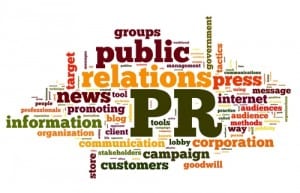 I recently spoke to a group of students visiting Ketchum’s London office about the evolution of the Public Relations industry and potential career paths within the field. This post is intended to share similar insights for other budding PR students looking to plot their careers in our fast-changing industry.
I recently spoke to a group of students visiting Ketchum’s London office about the evolution of the Public Relations industry and potential career paths within the field. This post is intended to share similar insights for other budding PR students looking to plot their careers in our fast-changing industry.
The world of PR has changed a lot in the last century, as have the creatures that inhabit it.
Originally, PR man – and they were almost exclusively men – were former newspaper journalists. They had connections with reporters and editors, they knew what news was, and they understood the power of a headline long before anyone talked about ‘earned’ media or integrated marketing. Clients hired them to promote products with ‘free’ publicity or, in the event of a problem, to keep their names out of the paper.
The typical PR man worked locally, as most papers served local markets, until the 30s and 40s, when radio and eventually television introduced the notion of truly national audiences. You could argue that this began a bit earlier with the First World War, but commercial PR really took off in the 50s. Some of these PR men joined together to form agencies, while others joined advertising agencies to form PR departments.
Some of these agencies grew into national, and then international businesses, but the core service remained relatively unchanged: helping clients understand and be a part of the news.
For decades, the tools of the trade remain relatively unchanged:
– Press releases: content packaged for easy replication by journalists
– Photo opportunities and stunts: images staged for maximum impact
– Press conferences: controlled events orchestrated to release information with maximum excitement
This is not to say that NOTHING changed.
The PR man began to specialize by industry or vertical sector; a reflection of the fact that news media became increasingly specialized itself.
Academics began studying PR, both in theory and practice. Some focused on mass communications theory, others on behavioural psychology or economics, while others were interested in public relations not so much as a marketing tool but as a management discipline. It was the latter that introduced the idea that PR shouldn’t be a one-way street between a company and the public, but a process for aligning an organization’s behaviour with the expectations of its stakeholders.
So PR began (after 70 or 80 years of growing pains) to mature. It became more professional, more knowledge-based, and with the introduction of trade associations and professional societies, more ethical. It also became more female – much more, and though I haven’t been able to confirm the correlation, the female boom could perhaps be the catalyst of its evolution.
But it wasn’t until the 1990s that the PR landscape began a rapid transformation that is still playing out today. The agents of change in PR are the same as virtually every business today:
– Globalization: new markets, competitors, and opportunities arising all over the world
– Technology: the internet obviously, social media, and mobile devices
– An Emerging World View: everything is changing, everything is connected and nothing will ever be the same again … this theme plays out in every aspect of business, society, personal relationships, education…the list goes on.
And it’s this new view that’s changing the typical PR man or woman in ways that our forefathers would have found incredible.
In fact, there is no such thing as a typical PR profile these days, and those trained or employed as journalists have long had to re-invent themselves for this new world order (although the ‘news’ agenda and understanding how it works is still a big part of the value we bring).
I see the old prototype evolving into a many different skillsets and personalities – and who knows, maybe one appeals to you.
1. Trend-spotter: our clients are keen to know what the ‘next big thing’ is going to be. Actually, they want to BE the next big thing, but that starts with understanding how ideas pick up traction and go ‘viral’ within different communities. Every client values the ability of an agency to recognize and capitalize on emerging patterns in real-time.
2. Storyteller: story telling has become one of the most overused terms in marketing and communications, but there’s a reason for it’s use – clients want agencies to help them connect with their communities through narratives that are true, resonant, and are actionable. Stories of course can be told through many different forms of media, so we’re hiring not only writers and editors, but also filmmakers and producers, artists and designers, and psychologists who understand that what we say is not as important as what a community hears.
3. Digital pioneer: if you had told me a decade ago that the IT department may be the most important in the agency, I might have laughed. Now I think it IS the agency, and one of our industry’s biggest challenges is attracting those who understand technology and how it can help achieve our business goals.
4. Data geek: one criticism of PR has been its lack of predictability. An ad may or may not be effective, but at least you can guarantee it will be seen. As an industry, and particularly at Ketchum, we have begun to tackle this by making research a priority in every aspect of our service proposition. Our recommendations are informed by analysis of data, and client investments are evaluated qualitatively and quantitatively.
5. Producer: I had a boss once who said there’s no business like show business, and PR is show business. Never has this been truer. We once designed events, product launches, and major announcements to convey a certain mood or message in the hope that journalists would replicate it more widely to their readers and viewers. We still do that, but now we know we’re also connecting directly with those readers and viewers through our own channels, and through them to each other.
6. Change agent: one of our fastest growing teams is our change management business, which makes sense. In a period of dramatic change, companies and brands need A LOT of help. Our change managers help clients plan and activate a process for moving organizations from one state to another, usually focusing first on their employees and internal stakeholders. This brings them into contact with the most senior executives of companies, and places them at the heart of the business strategy.
7. Provocateur: as I said, our business went unchanged for nearly a hundred years, then everything started changing at once. The same is true for our clients, regardless of where they are and what they do. Some are quick to adapt while others have only begun to raise their heads above the parapets. We’re at our best when we bring all of our best resources together – our geeks and producers, influencers and storytellers – and literally provoke them into changing.
I can only imagine the face of PR in another 20 years.
Good luck!


